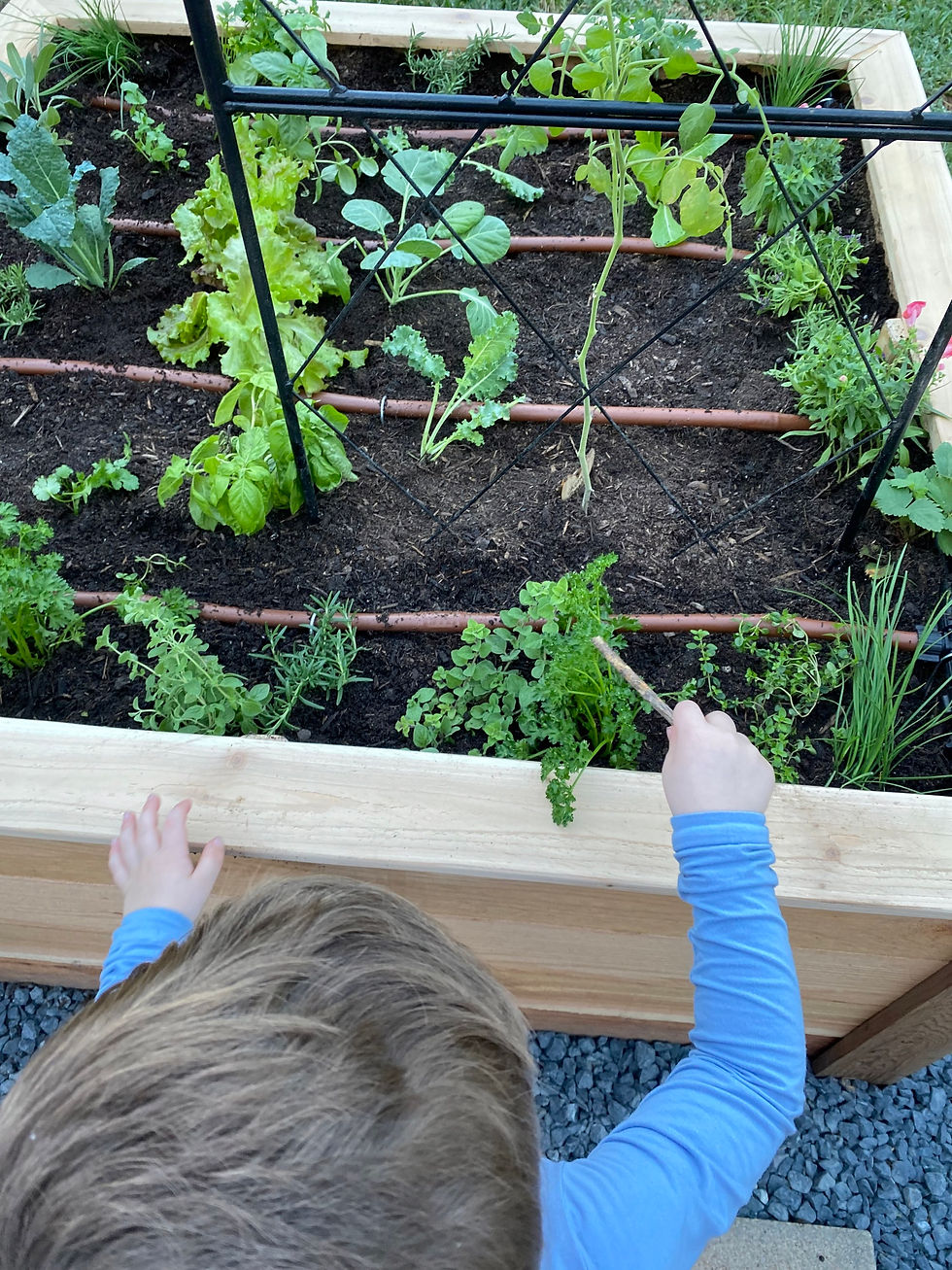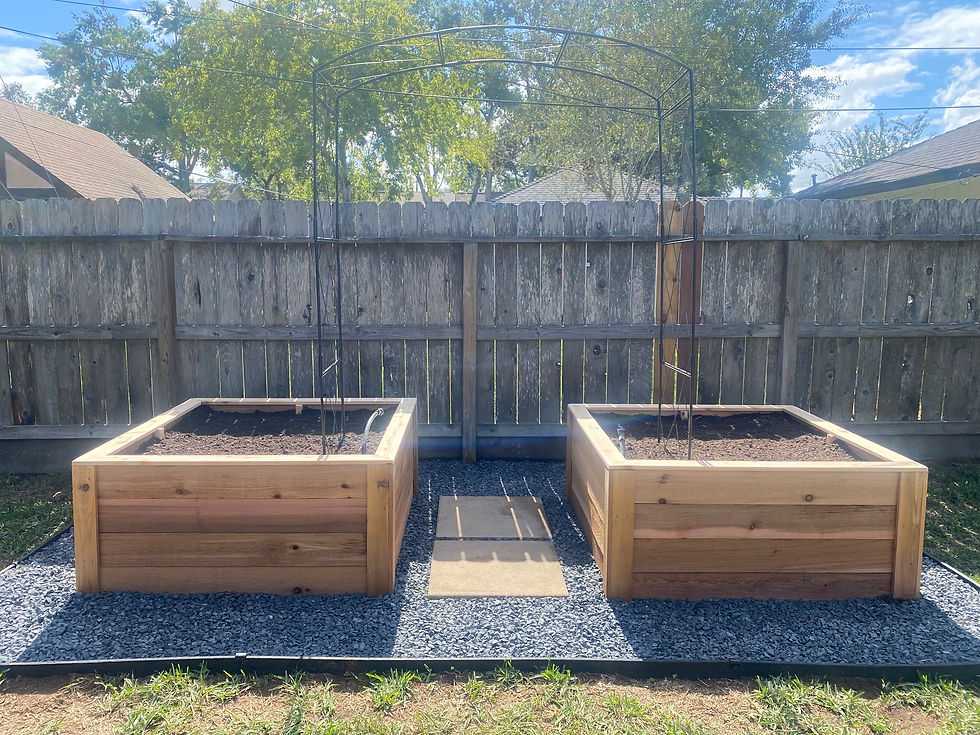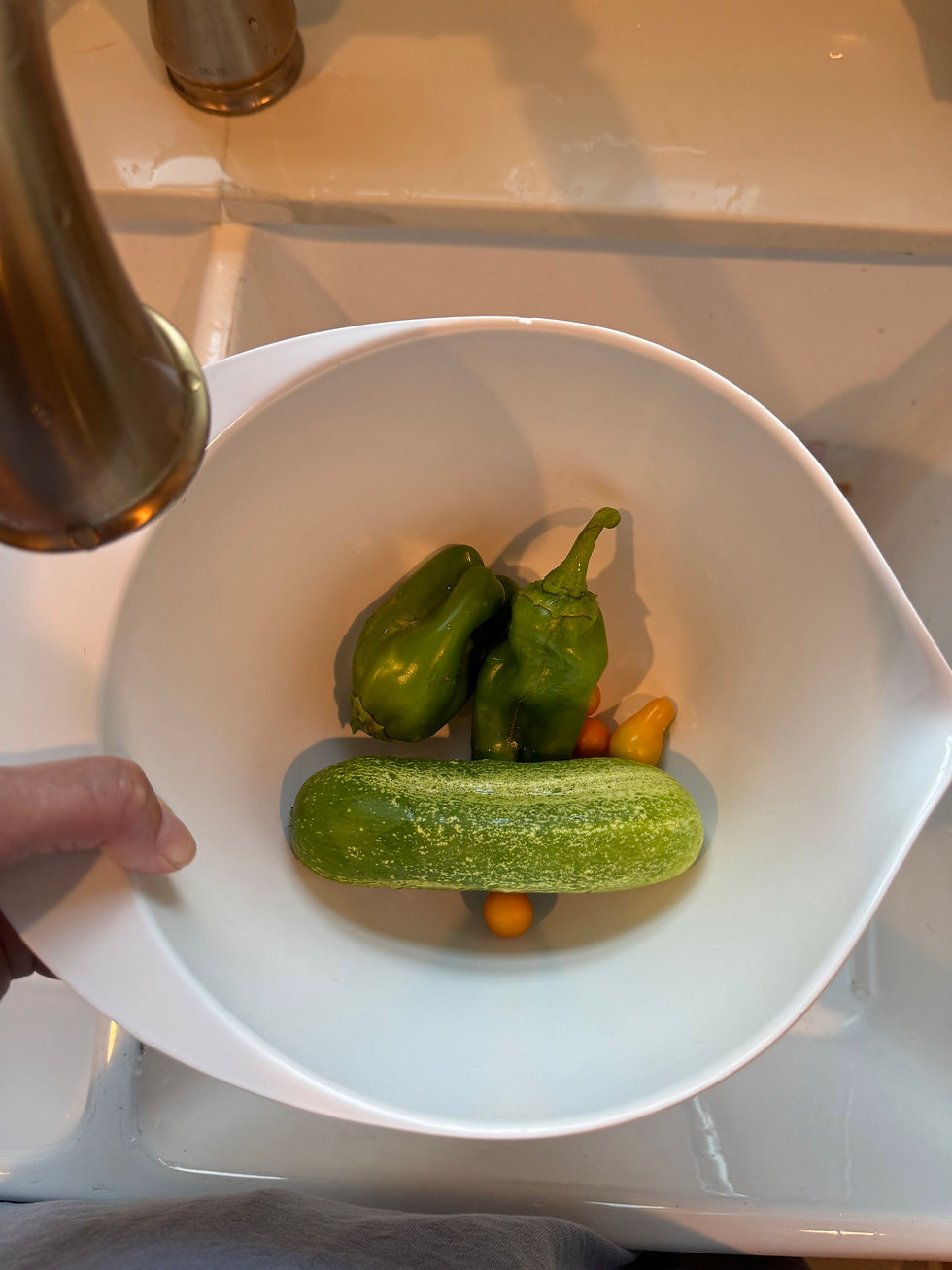Kitchen Garden 101
- Ashley Daugherty

- Aug 20, 2024
- 5 min read
Updated: Sep 29
Ever wonder how these ethereal content creators always have fresh and vibrant fruits and vegetables on hand at any notice? Well, they either hit up their local farmers market each weekend, or they have their own garden in their backyard. I am not talking a farm lined with perfectly spaced lettuce patches and strawberry fields, they most likely have a simple kitchen garden that can feed their family efficiently.

I started my own kitchen garden last year after my mother expertly maintained her own. I loved the idea of being able to grow a perfectly ripe tomato all by myself. In fact, I tried my hand at gardening before I had kids. I used a little wooden barrel filled with grossly chemical infused dirt and a haphazard tomato plant that I bought from Home Depot. Lets just say it didn't turn out as I imaged. And I wont even tell you about the mint catastrophe. Just know, mint is invasive so DO NOT plant it with other veggies.
In my mind, I envisioned myself elegantly strolling outdoors to gather freshly picked lettuce for the autumn harvest salad I planned to prepare in my immaculately cleaned kitchen. Nevertheless, I soon discovered that gardening is not as glamorous as it may appear. It requires getting your hands dirty to create something beautiful and demands a hell of a lot of hard work. However, I assure you that once you get the hang of it, you will catch yourself sneaking out of the house to inspect your newly sprouted zucchini blossoms.
Kitchen Gardening 101
The concept of a kitchen garden is exactly as it sounds - the practice of cultivating your own food in your backyard to provide for your yourself or your family. It takes the idea of making something homemade to a whole new level, and I will show you 5 simple steps on how to start your own.
1. Planning Your Kitchen Garden
Location, Location, Location!
First things first, find a spot with enough sunlight for your plants to soak up those rays. Find an area of your yard that isn't shaded from a big oak tree. Remember that your garden also does not need to start big. You can even turn an already formed flower bed into a garden by adding a raised bed. Kitchen gardens are meant to not only be useful for consumption, but add to the esthetic of your space.


These are the garden beds that we put in my own backyard. We watched for how the sun would hit this area for 24 hours before deciding to put the garden spot here!
2. Building Your Garden Beds
Cedar beds are highly favored not only for their durability but also for their natural resistance to pests, making them a reliable choice for gardeners looking for long-lasting solutions. On the other hand, garden beds made from galvanized metal offer a sleek and modern alternative, adding a contemporary touch to any garden space. When it comes to filling these beds, a well-balanced mixture of earthly, organic soil is what will make your garden flourish. Don't cheap out on this part. I use a mixture of organic rose soil and compost. This combination provides essential nutrients for plant growth while ensuring proper drainage and aeration. Ultimately, choosing the right soil mix for your garden beds is a key factor in creating a thriving and flourishing garden space.

My dad actually built these cedar beds himself! If you are handy, there are plenty of DIY designs online for building your own garden beds. Or you can use a company like Gardenary (https://www.gardenary.com ) that has cedar bed kits that can easily be put together!

This is a garden bed that we made in Bandera, Texas at my parents Hill Country home! We planted low maintenance veggies such as sweet potatoes and beans. Notice the pollinator flowers in the back and the herbs around the edges. We will get to that below!
3. Installing an Irrigation System
Keeping your garden well-watered is a must, so think about different ways to water your plants, whether you set up a DIY system or get some pro help. Don't slack on maintaining your irrigation setup – it'll pay off big time by keeping your plants healthy and productive.

My dad put in our irrigation system. He taught me and if you already have a sprinkler system in place, it is not hard to add on drip irrigation. Once again, you can always call in the big guns, but doing it yourself will save you money of course.
4. Planting Your Herbs
Planting herbs around the border serves as a natural pesticide to garden pests. Herbs like basil, rosemary, parsley, and cilantro are excellent choices for pest control due to their aromatic properties that deter unwanted insects. This herb companion planting not only helps protect your vegetables but also adds a fragrant and visually appealing element to your garden. Let alone, you always have fresh basil on hand!

5. Packing Your Garden with Vegetables
A typical farmer might cringe at the thought of you closely planting your lettuces and bush beans. However, for a kitchen garden, we are not trying to grow perfectly maintained vegetables to be sold at Trader Joes. We are growing for our own enjoyment and sustainability. So, go ahead and pack those vegetables in.


Additional Tips
Adding a Trellis for Vining Plants
When you're growing plants like vining tomatoes and cucumbers that like to climb, it's super important to give them the right support. Putting up a trellis gives them something to hold onto and helps them grow big and strong. You can find all kinds of trellises out there, from simple stakes to fancier setups, so make sure you choose one that works for your garden. And don't forget to train your plants to climb up the trellis to make the most of your space and sunlight.


Seasonal Considerations
Growing plants seasonally is like following a recipe - you wouldn't bake a cake without knowing when to add the flour, right? For more detailed guidance, check out resources like the Farmer's Almanac - it's like having a wise gardening grandparent in book form. And remember, understanding frost dates is crucial - protect your plants like they're your children in a snowball fight.

Adding Pollinating flower plants
Adding flowers to your garden not only elevates the look of it, but it a necessary part of the gardens ecosystem. Most flowering veggies need to be pollinated in order to grow into an actual vegetable you can enjoy in a dish. That is why the buzzing bee is our best friend. They are your partner crime and will get the job done for you. Below is a picture of a beautiful okra blossom from my moms garden.


My favorite go-to flower to put in the garden are Zinnias. You can dump a packet of seeds in, and watch them take flight.
Embarking on the journey of creating your own kitchen garden can be a fulfilling and enriching experience. By starting small and allowing yourself to experiment, you can gradually cultivate your green thumb and witness the fruits of your labor. So, roll up your sleeves, dig in the soil, and enjoy the process of tending to your very own kitchen garden.


It might not be enough to feed an army, but I grow just enough veggies to show off to my family and say those magic words, these are from the garden.
XO,
Ashley




Comments